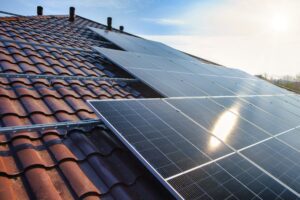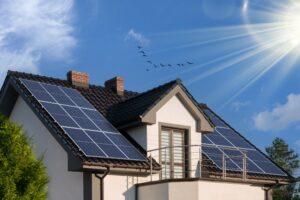When it comes to producing free electricity with solar panels, size matters. However, the question of solar panel sizing can be confusing. Most of us understandably think of size in terms of physical dimensions. But solar panel installers are usually talking about power output when referring to solar panel size.
If you’re considering switching to solar to cut energy costs and reduce carbon emissions, this guide will explain everything you need to know about solar panel size and dimensions. This will help you choose a system according to the roof space you have available and with the right amount of power for your home.
Solar Panel Size Vs Solar Panel Dimensions
Incorrectly sizing your solar panel system can result in spending more than you need to or ending up with a system that’s too small to meet your needs. Get the sizing right and you’ll maximise the financial and environmental benefits of your solar panels. A variety of solar panel sizes and dimensions are available, depending on the manufacturer and panel type.
Panel dimensions don’t necessarily directly correlate with size in terms of power output. More powerful solar panels may not always require larger dimensions. The main factor to consider, therefore, is solar power output – how much energy your solar panels can generate.
And there’s not a great deal of flexibility when it comes to choosing solar panel dimensions; they’re pretty much of a standard size. That said, you may be limited by the amount of roof space available.
- Create a Tailored Quote Based On Your Circumstances
- Takes Less Than 2 Minutes
- Fixed-Online Quotes

Solar Panel Size: Power Output (Wattage)
Solar panel size refers to the amount of power a solar panel can produce over a given time. It’s stated in wattage – the voltage multiplied by amperage (V x A = W).
Voltage is the rate of speed/pressure of electrons moving through an electrical circuit. Volts are named after Italian physicist Alessandro Volta, credited with inventing the electric battery. Amperage refers to current – the number of electrons moving through the system. Amps are named after French physicist André-Marie Ampère, who founded the science of electromagnetism. Wattage is the rate at which energy is generated or used. Watts are named after Scottish inventor and mechanical engineer James Watt, who also designed the first steam engine.
There are a couple of other terms you need to know when considering solar panel size. A kilowatt is one thousand watts and a kilowatt hour (kWh) measures the total amount of solar power generated by the hour.
Solar Panel Wattage Ratings
The wattage of a solar panel is the maximum amount of power it generates when exposed to sunlight under ideal conditions. Common residential solar panel wattages in the UK are 250W, 300W, 350W and 400W, but higher ratings are available.
A solar array consists of multiple solar panels that generate a lot of power, so total output is measured in kilowatts (kW) – one unit of 1,000 watts. For example, ten 400W panels in a solar array gives you a 4kW system. Common solar panel system kilowatt ratings by house size in the UK are:
- 2kW system for a small home (one or two bedrooms).
- 3.5kW to 4kW-plus for a medium-sized home (two or three bedrooms).
- 6kW for large houses (with four or five bedrooms).
- 12kW systems for properties (with more than five bedrooms).
You need to bear in mind, though, that solar panels rarely reach these levels of output in the real world. Various factors can affect actual solar output (more on this later).
Solar Panel Size In Dimensions
The dimensions of a solar panel are its physical size in terms of length, width, and thickness, including the frame. You need to know whether you have adequate roof space for your solar panels, and their dimensions will give you an idea of the overall scale of the solar energy system you’re considering.
Dimensions may differ between manufacturers but residential solar panels on average contain about 60 solar cells and are around:
- 1.7 metres long (5.5 feet).
- 1 metre wide (3.2 feet).
- 3cm to 5cm thick (1.2 to 1.9 inches).
- Create a Tailored Quote Based On Your Circumstances
- Takes Less Than 2 Minutes
- Fixed-Online Quotes

Solar Panel Weight
Domestic solar panels usually weigh 18kg to 20kg. Solar panel weight is important when ensuring your roof is capable of bearing the extra load. Otherwise, there’s a risk of roof damage that’s not only dangerous but costly to repair.
However, most roofs can take 10kg a square metre. The average weight load of a solar panel on a slanted roof is only around 1.3kg per square metre. To be on the safe side, professional solar panel installers like Effective Home will always make sure it’s safe to install solar panels on your roof.
How Much Roof Space Do Solar Panels Take Up?
In general, the more solar power you want to generate, the larger the solar array and the more roof space you’ll need. Here are some typical examples.
- 8 x 300W solar panels – 15m2.
- 12 x 400W solar panels – 22m2.
- 16 x 500W panels – 30m2.
- 20 x 600W panels – 37m2.
How Many Solar Panels Do I Need?
The number of solar panels you need depends on the size of your home and your power requirements. The larger your household, the more panels you’ll need, taking up more roof space.
Here’s a rough guide.
- 2-3kW solar panel system (for a one- or two-bedroom home) – five to eight 350W panels or four to six 450W panels.
- 4-5kW system (for a two- or three-bedroom home) – 10 to 13 350W panels or eight to 10 450W panels.
- 6kW system (for a four- or five-bedroom home) – 16 x 350W panels or 13 x 450W panels.
Solar Cells And Energy Efficiency
Besides size and dimensions, solar panel power output is also determined by the energy efficiency of the system. Solar panel efficiency is the percentage of daylight turned into electricity. It varies according to the type of solar cells in the system.
Solar photovoltaic (PV) cells absorb electromagnetic radiation from the sun and convert it into electricity.
Monocrystalline solar cells have the highest energy efficiency rating – 15 to 24 percent. This is because they’re made of single crystals of pure refined silicon. Polycrystalline solar cells achieve 13 to 16 percent efficiency. They consist of fragments of silicon crystal bonded together. Thin-film silicon solar panels are seven to 10 percent efficient and contain layers of semiconducting materials.
The wattage output of solar panels is also affected by the number of solar cells they have. Panels with a larger surface area containing more cells generate higher currents and voltages, resulting in more impressive performance and output.
Solar panel efficiency is being improved by advances in solar technology such as PERC (passivated emitter and rear contact), perovskite cells, and bifacial cells. These systems enable smaller panels to produce as much or more energy as those with larger surface areas.
Importance Of Solar Energy Efficiency
The more efficient your solar panels are, the more electricity they produce and the less you have to rely on the National Grid to power your home. This means lower electricity costs. According to the Energy Saving Trust, you could save up to £545 on your energy bills in 2024. And maximising your home’s green energy production allows you to earn money from the Smart Export Guarantee, too.
The Smart Export Guarantee
Under the government-supported Smart Export Guarantee (SEG), major energy providers are required to pay you for solar energy you don’t use and send to the utility grid. SEG was introduced in 2020 to replace the more complicated Feed-in Tariff (FiT). To qualify for a SEG tariff, your solar panel system needs to be approved by the Microgeneration Certification Scheme (MCS), the independent industry standards organisation.
SEG licensees set their own tariffs and you get paid for each unit of electricity you export to the grid. Depending on the size of your solar energy system, you could earn up to more than £600 a year in SEG payments.
Here are some typical examples of annual SEG payments for 2024.
- 3kW solar panel system – SEG payments of £80 to £240.
- 4kW system – SEG payments £110 to £340.
- 5kW system – SEG payments £140 to £440.
- 6kW system – SEG payments £180 to £540.
- 7kW system – SEG payments £200 to £640.
What Affects Solar Power Output?
Solar panel power output is rated by how many watts are produced under standard test conditions (STC) in a laboratory. However, rooftop solar panels don’t operate in a lab environment. Various external factors affect the efficiency of solar systems. So they usually achieve only about 85 percent of the stated kilowatt peak power (kWp).
Besides the type of solar cells, variables that affect real-world solar output range from solar panel dimensions to issues relating to the local environment and how well the panels are maintained.
Solar Panel Dimensions
Larger solar panels can accommodate more solar cells so the system generates higher voltages and currents, which increases wattage output.
That said, a smaller panel with more energy-efficient cells can produce the same amount of power as a bigger panel with less-efficient cells. Solar panels are likely to get smaller, more efficient, and less costly as the technology advances.
Seasonal Changes
Solar panels generate electricity all year long but output varies with the changing seasons. They generate more power during the longer hours of daylight in summer. But if temperatures soar, the panels can overheat and generate slightly less power.
Solar panels produce less energy in winter, with fewer hours of daylight and the sun lower in the sky.
Roof Orientation
Solar panels are most effective when they get optimal sunlight – installed on a south-facing roof, at a 35-degree angle. But they will still produce power on an east- or west-facing roof, and at angles from 10 to 60 degrees where necessary, just less efficiently.
Shading
Significant shade – from trees or nearby buildings, for instance – can have a big impact on how much electricity solar panels generate. However, they’ll continue to work in partial shade and on cloudy days, although producing less power.
Maintenance
Solar panels mostly clean themselves when it rains. But power output suffers if they get less light because dirt or debris such as fallen leaves build up on the surface. Cleaning the panels manually once or twice a year and an annual professional inspection will ensure optimal performance.
- Create a Tailored Quote Based On Your Circumstances
- Takes Less Than 2 Minutes
- Fixed-Online Quotes

Solar Panel Costs By Size
Solar panel pricing depends largely on the size of the system with regard to power output. The higher the wattage, the greater the cost.
Larger households using more electricity need a more powerful solar installation. They typically consume around 4,100kWh-plus of electricity a year, compared with 2,700kWh for medium-size homes, and 1,800kWh in smaller homes.
Estimated costs of solar panel supply and installation in 2024 are as follows.
- 3kW solar panel system for a one- or two-bedroom home – £4,500 to £5,500.
- 4kW or 5kW system for a two- or three-bedroom house – £5,000 to £8,500.
- 6kW system for a four- or five-bedroom property – £9,500 to £10,500.
No VAT
Solar panel costs have been reduced by several hundred pounds with the scrapping of VAT on energy efficiency measures as part of the government’s drive towards net zero carbon emissions.
The zero VAT rate will continue until the end of March 2027, when it’s expected to revert to the original reduced rate of five percent. The same applies to solar batteries, which maximise the benefits of solar panels.
Savings On Electricity Bills
Powering your home with free energy from solar panels reduces reliance on expensive mains electricity from the National Grid. This can result in substantial savings and your solar panels will pay for themselves relatively quickly.
Although larger-size solar energy systems cost more, they save more money on electricity bills. For example, a 6kW system typically cuts energy costs by £1,000 a year, reaching payback point in 10 years. A 4kW system, with annual savings of £660, pays for itself in eight years, while a 3kW system saves around £440 a year, with a breakeven point of nine years.
With an expected lifespan of 25 to 30 years, solar panels will continue saving you hundreds of pounds a year long after they’ve paid for themselves, with total savings over 25 years in the region of £11,000 to £27,500.
Solar Panel Grants
Some households qualify for government-backed funding that covers the cost of solar panels or reduces it significantly. Various grants are available to low-income households whose homes have a low Energy Performance Certificate (EPC) rating.
Grant schemes include:
- ECO4, the fourth and final phase of the Energy Company Obligation, which runs until the end of March 2026, with £4 billion of funding available.
- ECO Flex, which makes funding available to more households, with local councils setting their own funding criteria.
- Home Upgrade Grant (HUG2), open to low-income households in certain areas with no access to mains gas for central heating.
- Warm Homes Programme (formerly Nest), which provides free solar panels for energy-inefficient homes in Wales in certain cases.
How To Get The Best Solar Panels For Your Home
When choosing solar panels, knowing which panel size and power output are right for your home is critical. Otherwise, you could end up with a system that’s larger and more expensive than you need or too weak to supply your household with enough electricity.
Various solar panel dimensions and sizes are available: there’s no one-size/dimension-fits-all solution. This may make it more complicated to choose the right solar panels but it gives you more flexibility in finding a system best suited to your household energy requirements.
Keep in mind that solar panel wattage and efficiency give you a better idea of performance and capabilities than physical dimensions. So you don’t necessarily have to choose bigger panels to get maximum power. A smaller panel with more efficient solar cells will produce as much electricity as a larger panel with less-efficient cells.
Leading national solar panel installer Effective Home will make sure you get the right size and dimensions of solar panels with optimal efficiency to meet your needs.
- Create a Tailored Quote Based On Your Circumstances
- Takes Less Than 2 Minutes
- Fixed-Online Quotes




